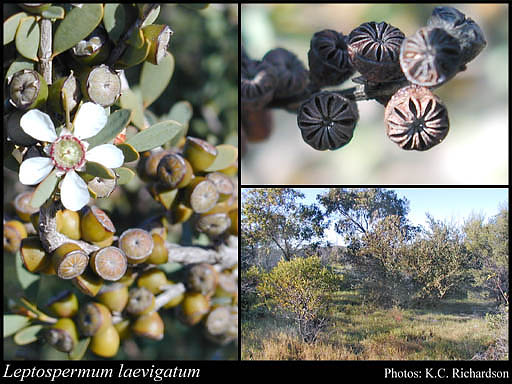This name is not current. Find out more information on related names.
- Reference
- Rep. (Annual) Austral.Natl.Bot.Gard. 22 (1858)
- Conservation Code
- Not threatened
- Naturalised Status
- Alien to Western Australia
- Name Status
- Not Current
Shrub or tree, 1.5-6 m high. Fl. white, Apr or Jul to Oct. White or grey sand, loam.

Management Notes (for the Swan NRM Region)
Alternative Names. coastal tea tree.
General Biology. Growth form. Shrub. Reproduction. Seed. Dispersal. Wind, vehicles, soil movement, water, garden refuse. Time to first flowering. 4 years. Vegetative regeneration strategy. Occasionally resprouts from base. Seedbank persistence. Short, days-1 year. Fire response. Adult plants are killed by fire, seed is released from woody fruits and germinates prolifically in post fire conditions.
Notes. Seeds released en masse when plants are damaged or streesed, including herbicide application, mechanical damage or fire.
Additional information. Origin. south-eastern Australia. History of use/introduction. Garden escape, planting for dune stabilization and for windbreaks.
Suggested method of management and control. Hand pull seedlings. Fell mature plants. Resprouting has been recorded in some areas. Where resprouting has been observed, apply 250 ml Access® in 15 L of diesel to bottom 50 cm of trunk (basal bark). Slash, fell, mulch Spray regrowth until just wet – 100mL Grazon® plus Pulse® in 10L water Standing plants (thickets) 10L/ha glyphosate plus 0.25% Pulse® for overall spraying or 100mL glyphosate (450g/L) plus 25mL Pulse® in 10L water – spot spraying Individual plants 200mL Access® in 10L diesel applied to the lower 50cm of each trunk in spring. Seedlings Manually remove seedlings 1 – 2 years Older seedlings cut 2cm below the soil surface Mature plants Cut and paint the stump with glyphosate, picloram gel or Access® Seedlings amongst other vegetation 3L/ha 2,4-D Ester 800 (or 4L/ha 2,4-D LVE 600) in 30L water – aircraft application (larger native species will survive these rates) Read the manufacturers' labels and material safety data sheets before using herbicides. For further information consult the Australian Pesticides and Veterinary Medicines Authority to determine the status of permits for your situation or state.
Management Calendar
| Calendar Type | Jan | Feb | Mar | Apr | May | Jun | Jul | Aug | Sep | Oct | Nov | Dec | Comments |
|---|---|---|---|---|---|---|---|---|---|---|---|---|---|
| Flowering | Y | Y | Y | Y | Y | ||||||||
| Fruiting | Y | Y | Y | Y | Y | Y | Y | Y | Y | Y | Y | Y | |
| Optimum Treatment | O | O | O | O | O | O | Y | Y | Y | Y | O | O |
Legend: Y = Yes, regularly, O = Occasionally, U = Uncertain, referred by others but not confirmed.
References
- Brown, K. & Brooks, K. (2002) Bushland Weeds: A Practical Guide to their Management. Environmental Weeds Action Network, Greenwood.
- Burrell, J.P. (1969) The invasion of coastal heathland by Leptospermum laevigatum (J. Gaertn.) F. Muell. Australian Journal of Botany, 29: 747-764.
- Hussey, B.M.J., Keighery, G.J., Dodd, J., Lloyd, S.G. & Cousens, R.D. (2007) Western Weeds. A guide to the weeds of Western Australia. 2nd Edition. The Plant Protection Society of Western Australia, Victoria Park.
- Lam, A. (2002) Ecology and management of Victorian Tea Tree (Leptospermum laevigatum) in Western Australia. Honours thesis, School of Natural Sciences, Edith Cowan University.
- Lam, A. and van Etten, E. (2002) Invasion of indigenous vegetation in south-western Australia by Leptospermum laevigatum (Myrtaceae). In Papers and Proceedings from the 13th Australian Weeds Conference (eds H. Spafford Jacob, J. H. Moore). Plant Protection Society of WA, Perth.
- Moore, J.H. & Wheeler, J. (2008) Southern weeds and their control. DAFWA Bulletin 4744.
- Navie, S. & Adkins, S. (2008) Environmental Weeds of Australia, An interactive identification and information resource for over 1000 invasive plants. Centre for Biological Information Technology, The University of Queensland.